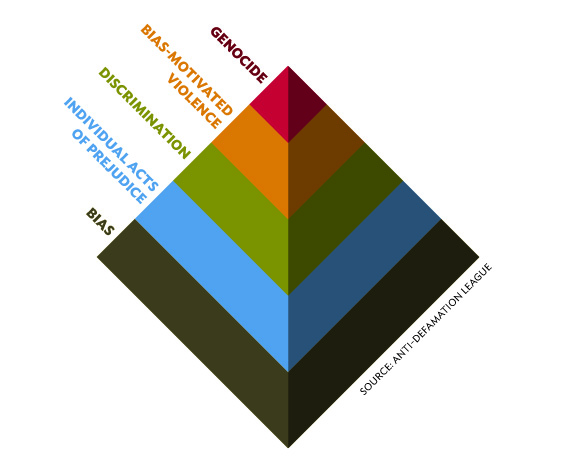It’s been a week filled with hateful violence in the United States of America.
Maurice Stallard and Vickie Lee Jones, both African Americans, were shot and killed at a Kentucky grocery store by an alleged gunman motivated by racial hatred.
For days in a row, high-profile Democratic leaders and other politically outspoken Americans received pipe bombs in the mail. The suspect is reported to be a right-wing extremist terrorist.
And then, today, news broke of a premeditated shooting at a Pittsburgh, Pennsylvania, synagogue that left 11 people dead. The man believed to be the killer is a known anti-Semite.
These attacks were committed by men with hatred in their hearts. And, although such moments can feel confusing and out of control, there is a time-tested model we can rely on to help contextualize these events.
It’s one we hope you’ll share with your students on Monday: the Anti-Defamation League’s Pyramid of Hate.

The Pyramid of Hate
The Pyramid shows biased behaviors, growing in complexity from the bottom to the top. Although the behaviors at each level negatively impact individuals and groups, as one moves up the pyramid, the behaviors have more life-threatening consequences. Like a pyramid, the upper levels are supported by the lower levels. If people or institutions treat behaviors on the lower levels as being acceptable or “normal,” it results in the behaviors at the next level becoming more accepted. In response to the questions of the world community about where the hate of genocide comes from, the Pyramid of Hate demonstrates that the hate of genocide is built upon the acceptance of behaviors described in the lower levels of the pyramid. (source: adl.org)
We’ve witnessed these hate-fueled moments so many times before, but that doesn’t mean we shouldn’t talk about them when they happen. Because when we don’t, we show our students that what’s happening is unremarkable.
We’ve normalized the next level of the pyramid. And what then?
In your class on Monday, talk about what happened in Pittsburgh. Show your students the pyramid, and use these resources to teach about the realities of anti-Semitism:
- TT’s free film One Survivor Remembers, and the accompanying teacher’s guide
- TT’s school climate resources, including Responding to Hate and Bias at School
- The Perspectives texts “Out of Auschwitz,” “About Feeling Jewish,” “Danger on My Doorstep,” “Letter to the Hebrew Congregation in Newport” and “What Is Talmud?”
- Facing History and Ourselves’ anti-Semitism and religious intolerance resources
- This classroom activity from the ADL, titled Anti-Semitic Incidents: Being an Ally, Advocate and Activist
- The United States Holocaust Museum’s tools and resources
But don’t stop there.
Remember that, on Friday, Matthew Shepard was laid to rest at Washington National Cathedral, 20 years after he was murdered for being gay. His name lives on in many ways, not the least of which is the Matthew Shepard and James Byrd Jr. Hate Crimes Prevention Act. That law also honors Byrd, a black man whose brutal murder received far less attention. The Act is now almost 10 years old, and yet the events of this week make it crystal clear that we are not doing enough to keep our country from moving to the next level of the pyramid.
Hatred this powerful can’t be stopped by a law, or by refusing to talk about identity, or by limiting our discussions of race, religion and sexual orientation to the home. Our children need to hear messages of acceptance, love and pluralism in every arena of their lives. To ignore these acts of violence is to accept them—a message no one living in this country can afford to send.
van der Valk is the deputy director for Teaching Tolerance.
